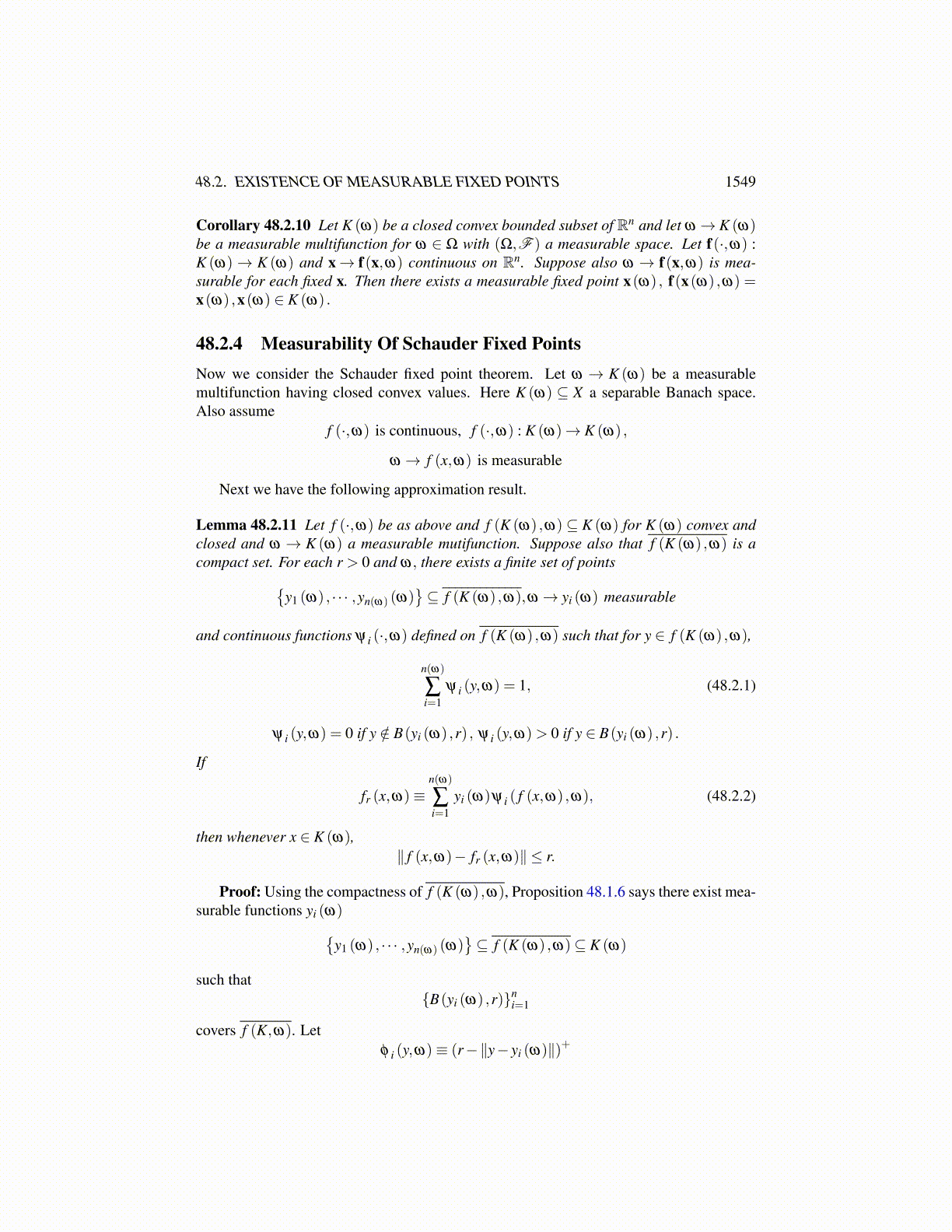
48.2. EXISTENCE OF MEASURABLE FIXED POINTS 1549
Theorem 48.2.7 Let E (ω) be a compact metric space in a separable metric space (X ,d)and that ω → E (ω) is a measurable multifunction where (Ω,F ) be a measure space.Suppose ψω : E (ω)×Ω→ R has the property that x→ ψω (x,ω) is continuous and ω →ψω (x(ω) ,ω) is measurable if x(ω) ∈ E (ω) and ω → x(ω) is measurable. Then thereexists a measurable function, f with f (ω) ∈ E (ω) such that
ψω ( f (ω) ,ω) = maxx∈E(ω)
ψω (x,ω) .
Furthermore, ω → ψω ( f (ω) ,ω) is measurable.
Proof: Let C (ω) = {ei (ω)}∞
i=1 be a countable dense subset of E (ω) with each ei (ω)measurable. Since ω → E (ω) is measurable, such a countable dense subset exists. LetCn (ω)≡ {e1 (ω) , ...,en (ω)} . Let ω → fn (ω) be measurable and satisfy
ψω ( fn (ω) ,ω) = supx∈Cn
ψ (x,ω)
This is easily done as follows. Let
Bk ≡{
ω : ψω (ek (ω) ,ω)≥ ψω (e j (ω) ,ω) for all j ̸= k}.
Then let A1≡B1 and if A1, ...,Ak have been chosen, let Ak+1≡Bk+1\(∪k
j=1Bk
). Thus each
Ak is measurable and you let fn (ω)≡ ek (ω) for ω ∈Ak, so fn (ω)∈E (ω). Using Corollary48.2.3, there is measurable f (ω) and a subsequence n(ω) such that fn(ω) (ω)→ f (ω) .Then by continuity,
ψω ( f (ω) ,ω) = limn(ω)→∞
ψω
(fn(ω) (ω) ,ω
)and this is an increasing sequence in this limit. Hence
ψω ( f (ω) ,ω)≥ supx∈Cn(ω)
ψω (x,ω)
for each n and so
ψω ( f (ω) ,ω)≥ supx∈C(ω)
ψω (x,ω) = supx∈E(ω)
ψω (x,ω) .
Since f is measurable, it is the limit of a sequence { fn (ω)} such that fn has finitelymany values on measurable sets, Theorem 11.3.10. We can assume each value of fn (ω) isin E (ω). Indeed, repeat that theorem’s proof applied to C (ω) , letting fn (ω) be the ek (ω)in Cn (ω) closest to f (ω) as done there where this happens on a measurable set wherein fact ek (ω) is maximally close to f (ω) out of all ei (ω) , i ≤ n. Hence, by continuity,ψω ( f (ω) ,ω) = limn→∞ ψω ( fn (ω) ,ω) and since ω → ψω ( fn (ω) ,ω) is measurable, sois ψω ( f (ω) ,ω).
Note the following: If you have the simpler situation where ψ (x,ω) defined on X×Ω
with x→ ψ (x,ω) continuous and ω → ψ (x,ω) measurable but E (ω) a compact mea-surable multifunction as above, then the conditions will hold because you would have